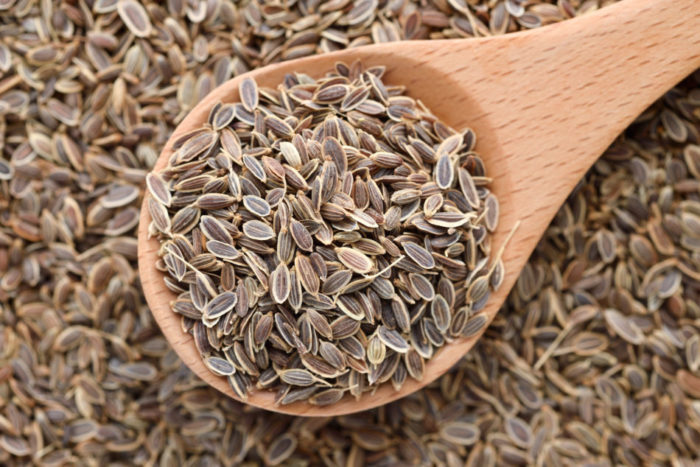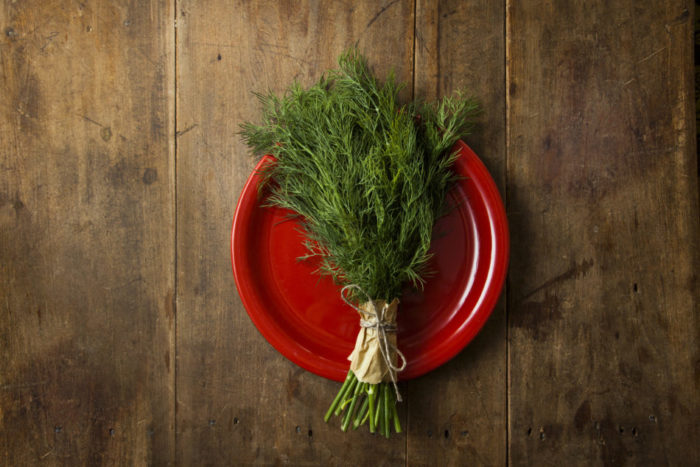Dill is an unassuming but fairly common herb used in a variety of recipes across the globe. The herb comes from the Apiaceae family, which also includes other common herbs like coriander (cilantro), celery, fennel, carrot, parsley, caraway, and parsnip. No wonder the herb has something in common with all these options!
However, it’s not just the herb that we use. Its roots, stems, and seeds are all good for culinary uses. So, let’s find out more about this plant and see how a dill seed vs dill weed comparison and use plays out.

Dill Seed VS Dill Weed – Comparison And Details
Appearance And Plant Origin Of Dill Seed And Dill Weed
It’s pretty easy and straightforward to tell apart dill seeds from dill weed. The term dill weed usually represents the green leaves of the plant, while the dill seed is flat and oval-shaped with a grayish-brown color with a white or cream border and stripes running through the seed. The relatively flat seeds of dill are something of a rarity and an interesting hallmark for this food.
Dried dill weed takes a color that’s brownish and more similar to the dill seed. Yet, the shape and specific characteristics of the dill seed keep it fairly distinct.

Flavor And Taste Comparison Of Dill Weed And Dill Seed
It should be no surprise that the seed and the fresh herb have very different flavors. Dill weed shows flavors similar to anise and celery, with a tanginess that’s somewhat better-known with cilantro. So, it draws heavily from the better-known flavors in its family.
Dried dill weed undergoes a transformation in its appearance and color. It’s slightly brown and feels lighter with a more crumpled look. In this case, the flavor of the herb is way milder than when it’s fresh. In this property too dried dill weed vs fresh dill weed has parallels to fresh vs dried cilantro. So, for most cuisines, it is the fresh and green dill weed that forms the key ingredient.
The dill seed has a flavor different from the fresh herb, but it doesn’t completely ignore its family roots. Dill seed flavor has similarities with caraway and some pungent notes with a rather camphorous flavor.
What Is Dill Weed?
Dill weed is also simply known as dill. This is a famous plant that finds use in several recipes and cuisines. The plant’s often called dill weed to differentiate it from dill seed, though calling it simply dill is acceptable too.
If you’d like to be very specific, dill weed represents the leaves and stem of the dill plant. It doesn’t include the roots or the seed. The small and tender stems are best for culinary uses. While the thicker stem might be used as well, its texture doesn’t seem to fit right with most recipes.
As we know, dill belongs to the Apiaceae family, which includes several famous plants and herbs. While some of these are very common and find a way into most recipes, the entire family isn’t all that benign. There are more than 3000 plants in the Apiaceae family, including the poisonous hemlock and several others like it.
Is Dill Weed The Same As Dill?
Dill weed is the same as the dill plant. The general assumption is that the name dill weed wins favor to clearly differentiate different edible parts of the plant. To be clear, dill weed refers to the green stems or leaves of the dill herb. This can also be extended to include the dried leaves and stems known as dried dill weed.
So, for most uses, dill weed is the same as dill. This separates it from the other common food product from the plant, its seed. The different naming system makes it easy to distinguish one commonly used part of the plant from the other.
In such a setup, dill weed is a term to represent the green parts, and often seen the same as dill. The seeds are separate and get the name of dill seeds.
FAQ And More Details
How Much Dry Dill Equals Fresh Dill?
As a rule of thumb, fresh herb to dry herb ratio is seen as 3:1. This stands true for dill as well. To explain further, if your recipe calls for one tablespoon of fresh dill, you can substitute it with one teaspoon of dried dill. Similarly, if you need one cup of fresh dill, it’s possible to use ⅓ cup of dried dill.
However, there is a slight hitch in this rule of thumb when using dry dill. In its dried form, dill loses some intensity of flavor. So, using ⅓ dry dill might not be the ideal substitution. On the other hand, going overboard with the dry dill might negatively affect the texture of the recipe.
What Is The Best Substitute For Dill Seeds?
Dill seeds have a taste with some similarity to caraway, though with notes of pungency and a camphorous flavor. This makes it a somewhat unique flavor that’s tough to substitute for. Thankfully, there are some useful options that can get the job done just right, if not exactly.
Here are a few substitutes to use for dill seeds:
- Caraway seeds
- Celery seeds
- Anise seeds
- Fennel seeds (not the ideal option, but okay to use in a pinch)
- Oregano (use this only if a substitution is absolutely necessary)
What Is The Best Substitute For Dill Weed?
Dill weed has a taste similar to anise and celery with something of a tangy undertone. This opens the door to meaningful substitution by several herbs common to the Apiaceae family, to which dill belongs as well.
The best substitutes for dill weed are:
- Fresh tarragon
- Fennel fronds
- Thyme
- Parsley
- Celery
- Basil
Conclusion
In their presence, texture, and uses, there’s a mountain of difference in a dill seed vs dill weed comparison. While dill weed refers to the green leaves and stems of the herb, dill seeds are the flat, brownish seeds of the same plant. Both of these foods have different tastes, flavors, and culinary uses. Yet, the confusion of similarity persists because of the labeling mistakes.
It’s useful to remember that dill and dill weed usually represent the green leaves and stem of the herb. While dill seeds refer to the seeds only.